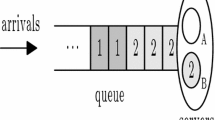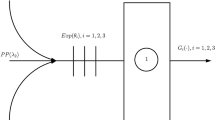Abstract
This paper considers a continuous-time queueing model with two types (classes) of customers each having their own dedicated server. The objective is to have a better grasp on the concept of a global first-come-first-served service discipline with presorting, i.e., all arriving customers are accommodated in one single FCFS queue, regardless of their type, with an exception of the first P customers. For the first P customers the FCFS rule holds only within the type, i.e., customers of different types can overtake each other in order to be served. Due to the global FCFS rule the model becomes non-workconserving and on the other hand we also have to keep track of the types of customers in the first P customers. The motivation of our work is the concept of a turn lane in road traffic, i.e., a lane reserved for vehicles making a specific turn at the next junction. This paper intends to be a step towards an analytic model to aid in the decision process of various policy makers of the optimal length of turn lanes.













Similar content being viewed by others
References
Baumann, H., & Sandmann, W. (2010). Numerical solution of level dependent quasi-birth-and-death processes. Procedia Computer Science, 1(1), 1561–1569.
Bruneel, H., Mélange, W., Steyaert, B., Claeys, D., & Walraevens, J. (2012). Influence of relative traffic distribution in nodes with blocking: an analytical model. In 26th European simulation and modelling conference, proceedings (pp. 136–143).
Bruneel, H., Mélange, W., Steyaert, B., Claeys, D., & Walraevens, J. (2013). Effect of global FCFS and relative load distribution in two-class queues with dedicated servers. 4OR, 11(4), 375–391.
Gail, H. R., Hantler, S. L., & Taylor, B. A. (2000). Use of characteristic roots for solving infinite state Markov chains. In Computational probability (pp. 205–255). Berlin: Springer.
Grassmann, W. (2003). The use of eigenvalues for finding equilibrium probabilities of certain Markovian two-dimensional queueing problems. INFORMS Journal on Computing, 15(4), 412–421.
Heidemann, D. (1996). A queueing theory approach to speed-flow-density relationships. In Proceedings of the 13th international symposium on transportation and traffic theory (pp. 103–118).
Kleinrock, L. (1975). Queueing systems, volume 1: theory. Hoboken: Wiley-Interscience.
Mélange, W., Bruneel, H., Steyaert, B., & Walraevens, J. (2011). A two-class continuous-time queueing model with dedicated servers and global FCFS service discipline. Analytical and Stochastic Modeling Techniques and Applications, Lecture Notes in Computer Science, 6751, 14–27.
Neuts, M. (1981). Matrix-geometric solutions in stochastic models: An algorithmic approach. Baltimore: The John Hopkins University Press.
Phung-Duc, T., Masuyama, H., Kasahara, S., & Takahashi, Y. (2010). A simple algorithm for the rate matrices of level-dependent QBD processes. In: Proceedings of the 5th international conference on queueing theory and network applications (pp. 46–52).
Sturm, J. (1985). Mémoire sur la résolution des équations numériques, mém savans etrang edn.
Van Woensel, T., & Vandaele, N. (2006). Empirical validation of a queueing approach to uninterrupted traffic flows. 4OR, 4, 59–72.
Van Woensel, T., & Vandaele, N. (2007). Modeling traffic flows with queueing models: A review. Asia-Pacific Journal of Operational Research, 24, 435–461.
Vandaele, N., Van Woensel, T., & Verbruggen, A. (2000). A queueing based traffic flow model. Transportation Research D, 5(2), 121–135.
Wilkinson, J. H. (1965). The algebraic eigenvalue problem. New York: Oxford University Press.
Acknowledgements
The authors wish to thank two reviewers for insightful comments that have strengthened the paper.
Author information
Authors and Affiliations
Corresponding author
Ethics declarations
Conflicts of interest
The authors declare that they have no conflict of interest.
Additional information
Publisher's Note
Springer Nature remains neutral with regard to jurisdictional claims in published maps and institutional affiliations.
Rights and permissions
About this article
Cite this article
Mélange, W., Walraevens, J. & Bruneel, H. Performance analysis of a continuous-time two-class global first-come-first-served queue with two servers and presorting. Ann Oper Res 310, 577–594 (2022). https://doi.org/10.1007/s10479-020-03741-2
Published:
Issue Date:
DOI: https://doi.org/10.1007/s10479-020-03741-2




